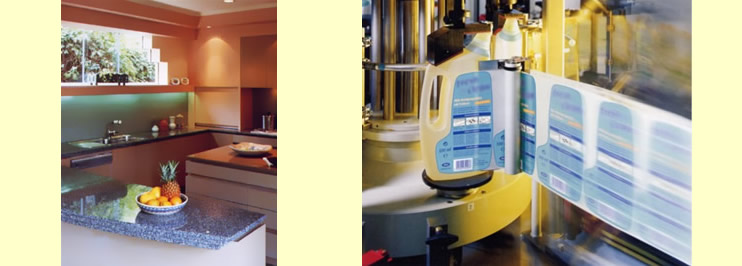  Silicones
for Bonding Silicones
for Bonding
Stickers, markings and labels are used in
all shapes and sizes. Before they can adorn the intended products,
they first have to be easily removable from their backing.
Cohesive and adhesive properties play key roles here. The properties
of silicones make them ideal for this application. The backing
materials for stickers are generally coated with silicones.
These reliably protect the layer of adhesive against contamination
and can withstand the extreme stress generated by printing
and punching operations.
Thin, even coats of silicone fluids have a low surface tension.
It ensures sure that the sticker adheres to its backing reliably.
But since weaker interactions occur compared with other substrates,
the sticker can be easily removed effortlessly any time.
The following diagrams show some examples from the vast range
of stickers possible (see also the experiment “Silicone-coated
paper”):

Stickers may be produced with or without
release film. Siliconized films are responsible for the so-called "No
Label Look", where the sticker is indistinguishable from
the packaging and packaging looks as if it has been printed
directly. Probably the best known example of this kind of sticker
is in shown in the diagram on the right. Since 1998, the Austrian
motorway vignette has been printed directly on siliconized
paper. There is no release paper to dispose of and the vignette
is barely distinguishable from the windshield. |
  GENIOSIL® silicones are ideal as adhesives for scratchproof work surfaces. Even in low concentrations, they permit the bonding of inorganic material to the unsaturated, organic polyester resins. The resulting composites are harder than natural marble and more resistant to dirt pick-up and detergents. GENIOSIL® silicones are ideal as adhesives for scratchproof work surfaces. Even in low concentrations, they permit the bonding of inorganic material to the unsaturated, organic polyester resins. The resulting composites are harder than natural marble and more resistant to dirt pick-up and detergents. |
 |
| DEHESIVE® silicones from WACKER are the perfect answer for self-adhesive, solvent-free stickers. They are used worldwide for labels on bottles, packages and cans, and also for posters in trains and airplanes. |
 |
 |
|